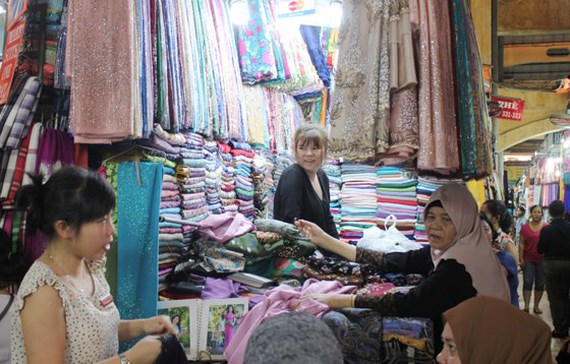On the other hand, the case of China-made silk trafficking in China, Khaisilk, can turn into a golden opportunity for silkworm rearing, silkworm rearing in Vietnam, to make completely "made in Vietnam" products. ".

Khaisilk imported silk from China to "made in Vietnam" to sell 5-10 times more expensive also raised the question why Vietnamese traders have to use this "trick"? And how the silkworm industry in Vietnam is developing ...
There is a paradox that while many Vietnamese merchants are silently importing Chinese silk in "mark in China" to label Vietnam, there are many Chinese tourists and traders come to Vietnam. To hunt for the silk and silk produced by Vietnam for sale or as gifts. The reason is that Chinese silk is very hot, and Vietnamese silk - like Van Phuc silk, for example, wears very cool. However, not only in Khaisilk, but in many souvenir villages, even in many souvenir shops, foreigners are selling silk to China. The reason that everyone understands is that imported from China a lot of models, and more importantly the price is very cheap. According to Nguyen Thi Tam, vice chairman of Van Phuc Silk Village Association (Ha Dong - Hanoi), the cost of 1m Van Phuc Silk is up to 400,000 VND to 1 million VND depending on the type, but only about 100,000 VND / m.
Through exchanges, artisans in silk-woven villages show that there are many reasons for traditional silk and silk to not compete with Chinese silk, because of the technology of weaving, technology, scale of investment, However, according to artisan Pham Khac Ha, the president of Van Phuc Silk Village Association, the main reason is that Vietnam does not have good source of silk for production, while the villages do not know how to advertise well. its brand.
From 2000 up to now, silkworm rearing areas in Vinh Phuc, Ha Nam, Hung Yen, Hanoi, Thai Binh and Bac Ninh have been wiped out. "We also need to enter the village of Van Phuc silk in Bao Loc - Lam Dong. There are only silkworm centers located in Mai Linh - Chuong My, about 4 - 5km away from the village, but only research functions, "said artist Pham Khac Ha.
On the other hand, the case of China-made silk trafficking in China, Khaisilk, can turn into a golden opportunity for silkworm rearing, silkworm rearing in Vietnam, to make completely "made in Vietnam" products. " According to Mr. Dang Vinh Tho, President of Silkworm Association of Vietnam, now the silk source is good for production, domestic silk weaving is not lacking. Currently, the country has about 10,000 ha. Despite the fact that 50% of the area is concentrated in Lam Dong Province, silk production in Lam Dong accounts for 70% of the country. Also in the north, due to low silk quality climate. Tho said that to this time, the sector of silkworm in Vietnam is recovering. The country has 40 automatic incubator plants. Particularly in Lam Dong, there are about 15 self-winding businesses that can produce more than 2 tons of silk per day. In addition, there are over 20 mechanical spinning facilities, producing nearly one ton of silk per day. Most of the finished silk is packaged for export abroad. Quality grade 1 is exported to India, Pakistan. Silk type 2 exported to Thailand, Cambodia, China.
Tastes of shopping and the spirit of supporting high quality Vietnamese goods is the opportunity to restore silkworm trade. However, one additional problem is that if we do not plan ahead for silkworm silk industry, then 10-15 more years will not have silk material to produce. The Department of Agriculture and Rural Development of Yen Bai, Son La, Lam Dong and Nam Dinh said that they are planning to re-establish silkworm mulberry growing. However, at present, the State needs to invest in the supply of good seeds. , yields high quality cocoons and silk, as up to 90% of the silkworm's current quilts are imported from China
VĂN PHÚC